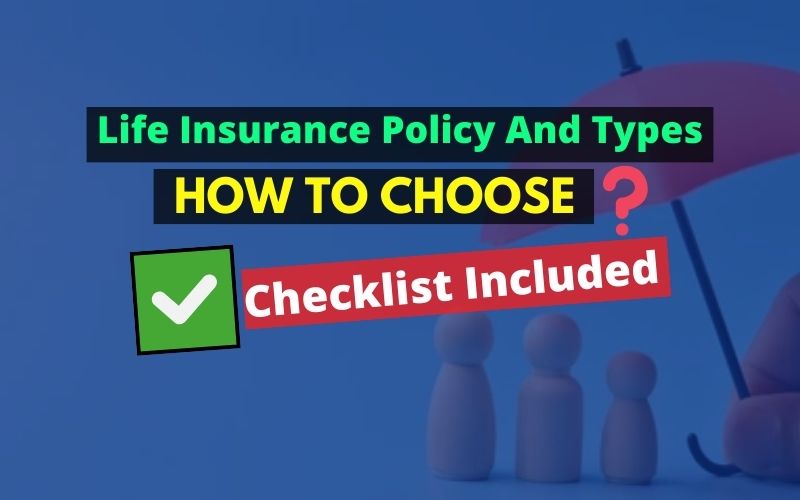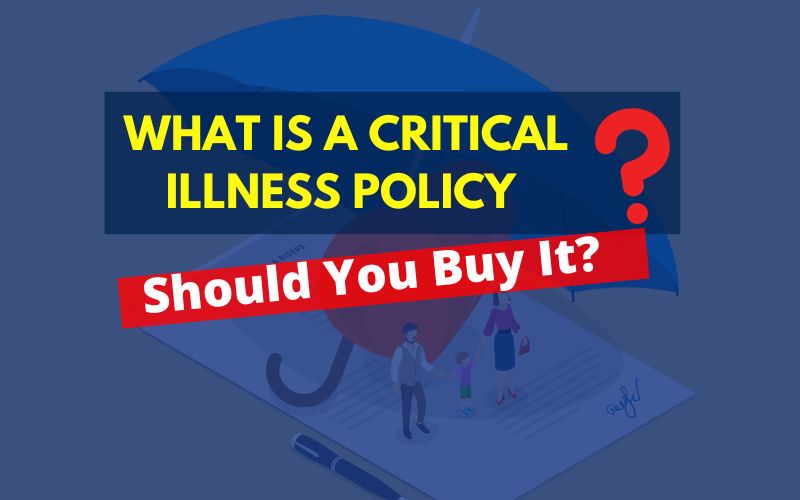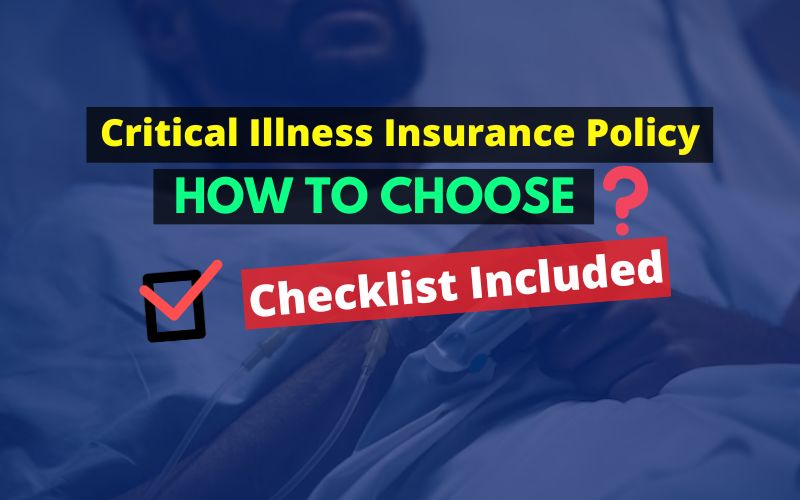Life insurance is a financial contract between an individual and an insurance company. In exchange for regular premium payments, the insurance company provides a death benefit to beneficiaries upon the policyholder’s death. Life insurance is a must-buy financial product to protect your family. In this article, we will learn more about life insurance and types, and the best way to protect your family along with the life insurance checklist.

Table of Contents
Benefits of Life Insurance And Types
Life insurance is a part of the financial foundation essential to protect your family’s financial future. Here are some key benefits of life insurance:
- 🔹Financial Security for Dependents: One primary benefit is that life insurance provides a financial safety net for dependents, such as spouses, children, or other family members, in case of the policyholder’s death. The death benefit can help replace lost income and cover living expenses.
- 🔹Debt Repayment: Life insurance proceeds can be used to pay off outstanding debts, including mortgages, personal loans, and credit card balances; this ensures that the policyholder’s obligations do not burden surviving family members.
- 🔹Income Replacement: Life insurance provides a source of income replacement for the family if the primary breadwinner dies; this ensures that the family can maintain its standard of living and meet financial obligations.
- 🔹Education Funding: Life insurance can be used to fund a child’s education. The death benefit can help cover educational expenses, ensuring that children have the financial means to pursue their academic goals.
- 🔹Peace of Mind: Knowing that loved ones are financially protected during the policyholder’s death can provide peace of mind. This emotional benefit is a significant aspect of life insurance, especially for those with dependents.
Life Insurance And Types: Different Types of Life Insurance Plans
- ◆ Term Life Insurance: Term insurance is a pure protection plan that offers coverage for a specific term, typically ranging from 5 to 30 years. If the insured person passes away during the policy tenure, the death benefit is paid to the nominee. It is one of the most affordable life insurance options and provides a high coverage amount for a relatively low premium. When it comes to insurance, this is the only insurance that one must hold based on one’s needs. These days, it’s a trend to have a one-crore cover. However, more than one crore might be required. Hence, it is better to find out how much life cover you need and buy accordingly rather than holding just one crore cover.
- ◆ Whole Life Insurance Plan: Whole life insurance covers the insured individual’s entire lifetime. It includes a death benefit and an investment component known as the cash value. The policyholder pays premiums throughout their life, and upon death, the death benefit is paid to the nominee or beneficiaries.
- ◆ Endowment Policy: Endowment plans combine life insurance coverage with a savings component. These policies pay out a lump sum to the insured or their beneficiaries upon maturity (if the policyholder survives the term) or in the event of the insured’s death. It offers a guaranteed sum assured along with bonuses or returns on investment.
- ◆ Child Insurance Plan: Child insurance plans are part of an endowment plan designed to support a child’s financial needs. These policies provide a lump sum to the child upon maturity or in the unfortunate event of the parent’s demise during the policy tenure. Some child plans also offer periodic payouts for funding the child’s education at different stages. However, the reality is that at the time of taking the policy, the plan is suggested for longer tenure without considering when the money is required, and due to stringent rules on withdrawal, it creates financial stress rather than security. Hence, it’s better to keep your life cover and investment separate to cover your life at a much cheaper premium in a term policy and choose the right investment product for investing.
- ◆ Money-Back Policy: The money-back policy provides periodic payouts during the policy tenure. If the insured survives the policy term, they receive the remaining sum assured along with any accrued bonuses at maturity.
- ◆ Unit-Linked Insurance Plans (ULIPs): ULIPs are market-linked insurance plans that provide life insurance coverage and investment opportunities in the equity market. A portion of the insurance premium is allocated towards life coverage, and the rest is invested in various funds (equity, debt, or balanced funds) based on the plan the policyholder chooses when taking the policy. And the policyholder also gets the option to switch between the plans if they wish to. The returns are subject to market performance.
- ◆ Pension Plans/Annuity: Pension plans or annuity policies provide the policyholder with a regular income during their retirement years. They allow individuals to build a corpus during their working years, which is then utilized to generate a steady income after retirement. Consider buying this policy when you are close to retirement with a minimum 3-5 year deferment period.
What Type of Life Insurance Policy is Best?
A term insurance plan is the best if you buy yourself and get group life insurance from your company; it can be even cheaper. However, as you may not work in the same company forever, it’s better to buy it yourself.
Checklist to Consider for Best Life Insurance
Here are the 3 points you must consider while selecting the best life insurance for yourself.
✔️Higher Claim Settlement Ratio – Say Yes
It is essential to check if the insurance company is not just settling but if it is settling on time. To check, you must consider two factors along with a higher claim settlement ratio :
- Three-year average claim settlement ratio: This helps understand the trend of their settlement.
- The proportion of claims paid out in under 30 days helps determine whether they do it promptly.
And if the 3-year average claim settlement ratio and proportion of claims paid out in under 30 days are above 97%, then you have selected the best life insurance for yourself. You can find this information in IRDAI’s annual report.
✔️High Amount Settlement Ratio – Say Yes
Just checking the claim settlement ratio is not enough. It would help if you also considered the high amount settlement ratio as some insurers are playing the number game where they are declining to pay out the few higher-value claims and settling most small claims to improve the claim settlement ratio. Amount Settlement Ratio above 90% should be good enough.
❌Critical Illness Benefit – Say No
The only benefit of adding Critical Illness as a rider to the life insurance policy is that the premium gets fixed until the policy term. In contrast, a standalone critical illness policy premium increases every five years (at age 20, 25, 30, and so on), just like a health insurance policy. However, I suggest buying a standalone Critical Illness Insurance due to the following:
- The term insurance rider critical illness has limited illness coverage. However, standalone Critical Illness covers several critical illnesses.
- The need for term insurance is only until you earn and your family financially depends on you. Your term insurance needs to get over if you have enough assets to cover your financial goals. Usually, post-retirement, you don’t need term insurance. However, if you club term and critical illness insurance, continuing the policy for maximum tenure becomes compulsory as you cannot separate the life and critical illness insurance.
- When you club the life and critical illness insurance and unfortunately claim for the critical illness, your policy tenure gets reduced by the claimed amount. Example: Mr. X bought a basic sum assured of 1,00,00,000 with a critical illness rider and happened to claim Rs. 20 lakhs for critical illness. Mr. X’s life insurance sum assured will be reduced by Rs. 20 lakhs, and now his life is covered with Rs. 80 lakhs only. Hence, keeping the cover separate and planning for a secured financial future is better.
✔️Solvency Ratio – Higher is better
The solvency ratio measures the insurance company’s ability to meet its long-term obligations and remain financially stable. In short, how is the company doing as a business?
A solvency ratio above 100% indicates that the insurance company has more than enough capital to cover its liabilities, suggesting financial strength and stability. Conversely, a ratio below 100% may signal potential financial distress, as the insurer’s capital may be insufficient to cover its obligations.
✔️Life Stage Benefit – Good to have
Some insurance policies allow you to increase your total term cover when you achieve significant life milestones, such as getting married or having a child; this is a nice add-on feature if you buy life insurance at a young age.
How to Buy a Life Insurance Policy in India?
In India, you can buy a life insurance policy directly from an insurance company or a broker.
To buy, you may visit the insurance company branch or buy online.
How Much Does Life Insurance Cost?
Term life insurance policies in India are not expensive. They provide a low-cost way to secure your family’s financial future. Never mix your insurance and investment.
To protect your family’s financial future, buy term life insurance and invest for goals separately. Financial planning helps you see your future in 360 degrees.
Insurance Claim Section 45 of the Insurance Act 1938
According to Section 45, a life insurance company cannot reject an insurer’s claim after three years from the
- Date of issuance of the policy
- Date of commencement of the risk
- Date of revival of the policy, or
- Date of the rider to the policy, whichever of the above is later.
Note: These conditions are subject to amendment from time to time.
In case of fraud, the Life Insurance Policy may be questioned within three years from any of the events mentioned above, whichever is later.
In such cases, the insurance company must give written notice to the insured, their legal representative, or nominees. The notice must mention the grounds on which the questions are raised.
Source: Indiacode
5 Common Mistakes You Must Avoid
- Mixing insurance and investment: This is most people’s biggest mistake; you get neither cover nor an investment return by combining.
- Being underinsured: Buying a life insurance policy without understanding the required cover. Underinsured will impact your family’s financial future in case of a mishap.
- Opting for life cover beyond age 65: It is a good practice to cover your life till your earning tenure up to age 60, and to be on the safer side, you can consider age 65.
- Opting for a limited premium paying term: Opting for a limited premium paying term means assuming you have bought a life cover of term 20 and opted to pay the entire premium within the first five years. You must know financially; it is not a wise decision. The insurance company shows its calculation that buying with limited PPT is a better choice without factoring in inflation. Hence, opt for annual premium payment only.
- Adding critical illness as a rider: As explained above, the only benefit of adding Critical Illness as a rider to the life insurance policy is that the premium gets fixed until the policy term.
Conclusion
It’s important to note that life insurance is for protection, and mixing insurance with investment neither protects your family’s financial future nor can it help you achieve your goals. Specific benefits and features can vary based on the type of policy (term life, whole life, universal life, etc.) and the insurance provider.
When choosing a life insurance policy, you should carefully review policy terms and conditions, as specific benefits and features can vary based on the type of policy and the insurance provider, and consider your financial goals and liabilities.
FAQ
Q: What is Term Insurance?
Term insurance is a pure protection plan offering coverage for a specific term, typically 5 to 30 years. If the insured person passes away during the policy tenure, the death benefit is paid to the nominee. It is one of the most affordable life insurance options and provides a high coverage amount for a relatively low premium.
Q: Why do I need life insurance?
Life insurance provides financial protection for your loved ones during your death. It can help replace lost income, cover debts, and support your family financially.
Q: What types of life insurance are available?
There are two main types: term life insurance, which provides coverage for a specified term, and permanent life insurance, which offers coverage for the entire life of the policyholder. Permanent life insurance includes whole life, universal life, and variable life insurance.
Q: How much life insurance coverage do I need?
It depends upon your financial contribution to your family, liability, assets created, and goals.
Q: What happens if I miss a premium payment?
If you miss a premium payment, there may be a grace period during which you can still pay without the policy lapsing. If the grace period expires and no payment is made, the policy may lapse, and coverage could be terminated.
Q: How to Claim Your Life Insurance Policy?
You can initiate a claim process by connecting with your insurance company online, through customer care, or by visiting their branch.








